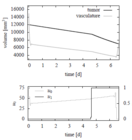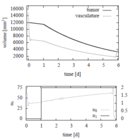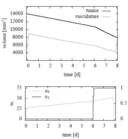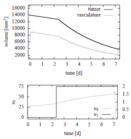Difference between revisions of "D'Onofrio chemotherapy model"
FelixMueller (Talk | contribs) (→Mathematical formulation) |
ClemensZeile (Talk | contribs) |
||
| (7 intermediate revisions by one other user not shown) | |||
| Line 3: | Line 3: | ||
|nx = 4 | |nx = 4 | ||
|nu = 2 | |nu = 2 | ||
| + | |nc = 4 | ||
}} | }} | ||
| Line 19: | Line 20: | ||
& \dot{x}_2 & = & u_0, \\ | & \dot{x}_2 & = & u_0, \\ | ||
& \dot{x}_3 & = & u_1, \\ [1.5ex] | & \dot{x}_3 & = & u_1, \\ [1.5ex] | ||
| − | & | + | & u_0 & \in & [0,u_0^{max}],\\ |
| − | & | + | & u_1 & \in & [0,u_1^{max}],\\ |
& x_2 & \leq & x_2^{max}, \\ | & x_2 & \leq & x_2^{max}, \\ | ||
& x_3 & \leq & x_3^{max}. | & x_3 & \leq & x_3^{max}. | ||
| Line 91: | Line 92: | ||
Image:d'Onofrio 4.png| Optimal controls and states with parameter set 4. | Image:d'Onofrio 4.png| Optimal controls and states with parameter set 4. | ||
</gallery> | </gallery> | ||
| + | |||
| + | == Variants == | ||
| + | |||
| + | * a variant where partial outer convexification is applied on the control and the continous control is replaces by binary controls, see also [[D'Onofrio model (binary variant)]], | ||
| + | |||
==Source Code== | ==Source Code== | ||
| − | [[:Category:Muscod | Muscod code]] | + | * [[:Category:Muscod | Muscod code]] at [[D'Onofrio chemotherapy model (Muscod)]] |
| − | + | ||
| − | + | ||
| − | + | ||
| − | + | ||
| − | + | ||
| − | + | ||
| − | + | ||
| − | + | ||
| − | + | ||
| − | + | ||
== References == | == References == | ||
<biblist /> | <biblist /> | ||
| − | |||
[[Category:MIOCP]] | [[Category:MIOCP]] | ||
| + | [[Category:Medicine]] | ||
[[Category:ODE model]] | [[Category:ODE model]] | ||
| + | [[Category:Bang bang]] | ||
| + | [[Category:Path-constrained arcs]] | ||
Latest revision as of 15:31, 11 January 2018
| D'Onofrio chemotherapy model | |
|---|---|
| State dimension: | 1 |
| Differential states: | 4 |
| Continuous control functions: | 2 |
| Path constraints: | 4 |
This cancer chemotherapy model is based on the work of d'Onofrio. The corresponding dynamic describes the effect of two different drugs administered to the patient. An anti-angiogetic drug is used to suppress the formation of blood vessels from existing vessels and thereby starving the tumors supply of proliferating vessels. In addition a cytostatic drug effects the proliferation of the tumor cells directly. The dynamic of the problem is given by an ODE model.
Contents
[hide]Mathematical formulation
For ![t \in [t_0, t_f]](https://mintoc.de/images/math/5/5/8/55823791d9100bcb5461801aff4f6edd.png) the optimal control problem is given by
the optimal control problem is given by
![\begin{array}{llcl}
\displaystyle \min_{x, u} & x_0(t_f) &+& \alpha \int_{t_0}^{t_f} u_0(t)^2 \text{d}t \\[1.5ex]
\mbox{s.t.} & \dot{x}_0 & = & - \zeta x_0 \text{ln} \left( \frac{x_0}{x_1} \right) - F \; x_0 u_1, \\
& \dot{x}_1 & = & b x_0 - \mu x_1 - d x_0^{\frac{2}{3}}x_1 - G u_0 x_1 - \eta x_1 u_1, \\
& \dot{x}_2 & = & u_0, \\
& \dot{x}_3 & = & u_1, \\ [1.5ex]
& u_0 & \in & [0,u_0^{max}],\\
& u_1 & \in & [0,u_1^{max}],\\
& x_2 & \leq & x_2^{max}, \\
& x_3 & \leq & x_3^{max}.
\end{array}](https://mintoc.de/images/math/f/e/2/fe2e01b68fb3e77b9a8def86725267bb.png)
where the control  denotes the administered amount of anti-angiogetic drugs and
denotes the administered amount of anti-angiogetic drugs and  the amount of cytostatic drugs. The state
the amount of cytostatic drugs. The state  describes the volume of tumor and
describes the volume of tumor and  the volume of neighboring blood vessels. The remaining states
the volume of neighboring blood vessels. The remaining states  and
and  are used to constraint the maximum amount of drugs over the duration of the therapy.
are used to constraint the maximum amount of drugs over the duration of the therapy.
Parameters
In the model these parameters are fixed.

The parameters  can be taken from the parameter sets shown in the following section. To the remaining parameters
can be taken from the parameter sets shown in the following section. To the remaining parameters  exists no experimental data.
exists no experimental data.
Reference Solutions
The problem can be solved with the [multiple shooting method]. For the following solutions the control functions and states are discretized on the same grid, with 100 nodes. The unknown parameters are chosen from the following parameter sets
Parameter set 1

Parameter set 2

Parameter set 3

Parameter set 4

Furthermore in the objective function  is chosen.
is chosen.
- Reference solution plots
Variants
- a variant where partial outer convexification is applied on the control and the continous control is replaces by binary controls, see also D'Onofrio model (binary variant),
Source Code
References
There were no citations found in the article.



